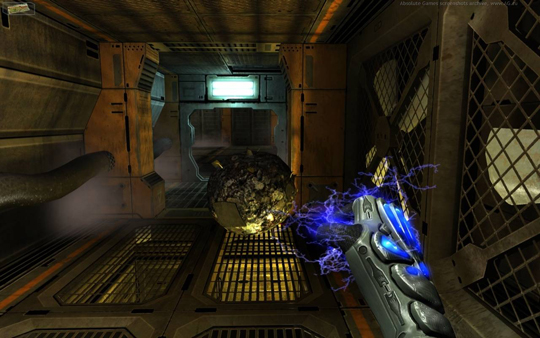Were Portal and Half-Life 2 to have a baby – is that incest? – the end result would not be Twin Sector. Primarily because the parents are already expecting, although it’s been a bit of a protracted pregnancy… Half-Life 2: Episode 3 will eventually plop out, deafening all with its newborn screams – keep the faith.
No, Twin Sector is its own Frankenstein’s monster, borrowing much more from Half-Life 2 than Portal. Yes, Twin Sector has physics-based 3D puzzles in enclosed areas. Yes, there’s a creepy AI always by your side. And yes, that central screen marker does look a bit like Portal‘s. This is all purely superficial, as the core mechanic is all but cloned from Half-Life 2‘s gravity gun. This core mechanic: the telekinetic gloves. These gloves work almost exactly like the gravity gun does: left click and hold to drag stuff to you, right click, hold, and release to hurl stuff at speed, you know the drill.
But what if Episode 3 never comes? Would Portal and Half-Life 2 be happy to call Twin Sector their child? In a word, no. In other words, they’d be better off giving it away for adoption. We might even be talking abortion.
Which is a shame, because the game does show glimmers of potential. The plot of being stuck in space with only a computer to call friend provides plenty of predictable sci-fi clichés, yet just enough twists and peculiar revelations to keep it interesting. Some of the puzzles display lofty levels of creativity, like the intracate domino-like placement of explosives barrels to blast through a wall with, or the zero-gravity navigation through huge, lethal, high-velocity fans. Moreover, the core concept of implementing gravity-gun-like mechanics into a physics-based puzzle game certainly has merit.

It just could’ve been so much better. It could’ve been good, it could’ve been okay, but in the end Twin Sector sadly dissapoints, and rapidly so. This is epitomized in its opening cutscene. Cinematic angles and haunting, scene-setting music quickly devolve into archaic texturing and detail, half-speed animations, and utterly catastrophic voice acting. The backstory’s revealed, kept vague enough to pique interest, but is so easily forgettable because of its surrounding presentation.
Or maybe because you’re stuck goggle-eyed, staring in disbelief at protagonist Ashley Simms, and not in a good way. She comes from the Lara school of visual design, her pornographic stature complemented by painted-on outerwear and unsettlingly unblemished features. She resembles a grotesque Second Life fantasy, relief only coming from not seeing anything more than her hands in the main first-person view.
All this would be forgivable, as forgettable as the backstory, if the puzzles proved interesting and appreciably challenging. They do not. They are very, very frustrating.
Why? Well, the game’s physics are very precise. This should be a good thing. However, when launching stuff away with the right glove, there’s not enough reassurance where said stuff is going to end up. The interface doesn’t help at all, with no lines of aim or reliable target markers. Similarly unreliable are the gloves themselves, the charge you unleash never feeling definite or predictable unless you absolutely always use full charge. Since the right glove proves significant in the vast majority of the puzzles, this presents trouble at a basic level, trouble that’s compounded by the regularly miniscule size of the targets you’re aiming at. Expect to see many barrels bouncing off walls, many switches gleaming untarnished, and many moments of subsequent nothingness.
The frustration doesn’t end there. Picking up objects is no picnic either, with water bottles, vital for dealing with the many fires in the game, breaking open at the tiniest of touches from anything. So how do you compensate for that? By making the corridors really, really narrow, obviously. This kind of hostile level design plagues Twin Sector, and makes for puzzle gameplay that is particularly lackluster.
In fairness, there’s some effort to keep the puzzles varied throughout, with new elements cropping up, like an explosive ball you have to lug around and some self-destructing drones that try to have limpet-like intimate relations with you. Sadly, Twin Sector falls foul too often of resting on recurring laurels. Lots of lasers attached to walls, lots of pipes to launch yourself onto, a few more lasers attached to walls, etc. There’s only so much variety a laser can provide.
The surrounding decoration for this repetitious, frustrating gameplay are grimy, bleak, grey walls and structures repeated over and over — Twin Sector could do with stealing Super Mario Sunshine‘s water gun — and a cascade of game-crashing bugs that are frequent and totally unpredictable. Quicksave is your friend, although each exceedingly long quickload will ask the question: is this worth any more of my time?
At around fifteen hours of crashing, poorly delivered cutscenes, unnecessarily thorny and intricate puzzles, not forgetting a complete lack of atmosphere and immersion, you’ll find yourself asking that question a lot if you do decide to give it a go. Maybe you’ll find that the merited core concept overwhelms the game’s flaws, and if you do, best of luck to you. Others, however, may prefer to play the inevitably good version of this game that will eventually come out — keep the faith, people.

















